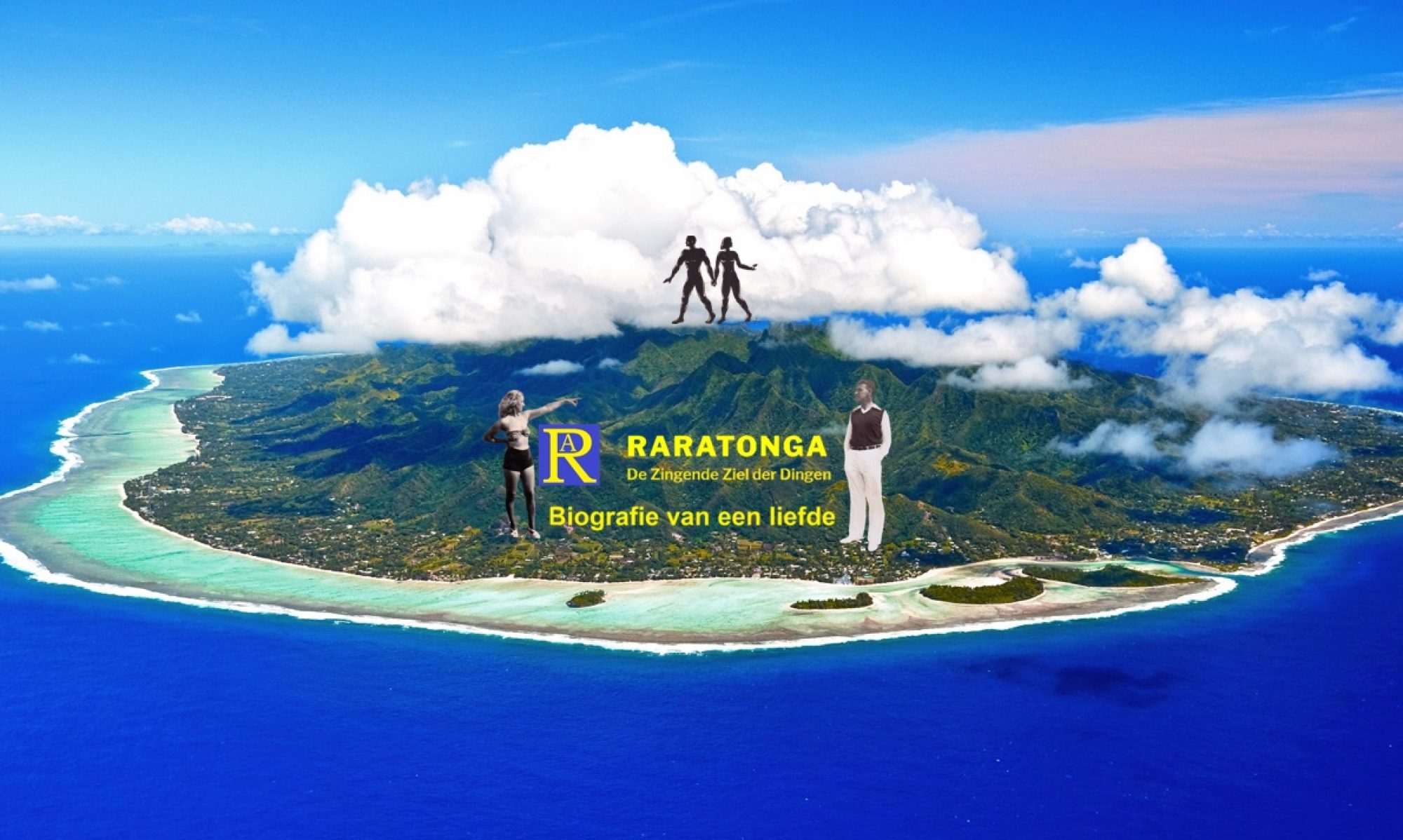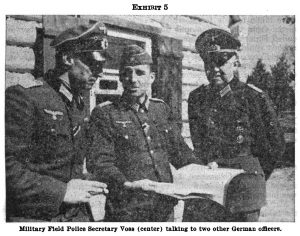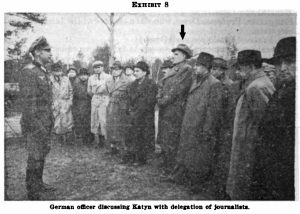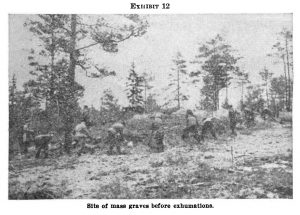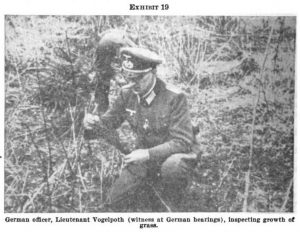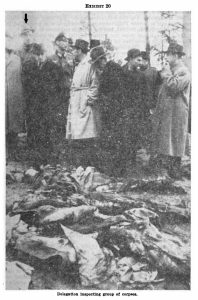In 1951-1952 werd in de Verenigde Staten door het Huis van Afgevaardigden een commissie in het leven geroepen om het Bloedbad van Katyn te onderzoeken: “United States House Select Committee to Conduct an Investigation of the Facts, Evidence, and Circumstances of the Katyn Forest Massacre“. De commissie raakte bekend als “Madden Committee”, naar de naam van de voorzitter: Ray Madden.
In september 2011 werden alle bevindingen en ondervragingen openbaar gemaakt, onder impuls van President Obama.
Interessant is de getuigenis van Paul Vogeltoth, die in de periode 1941-1943 werkzaam was o.a. als gids in Katyn voor de verschillende delegaties die er in 1943 op bezoek kwamen. Dus ook voor de groep journalisten waar Nand toe behoorde. Zo getuigt hij dat in de maanden maart tot juni 1943 ongeveer 200.000 mensen de massagraven bezochten. Enkel de speciale delegaties kregen begeleiding.
De belangrijkste passages van zijn getuigenis zijn in blauw gekleurd.
Op “Exhibits 8 en 20” is Nand herkenbaar.
(De naam van Paul Vogeltoth werd afgekort tot “Mr. V.”)
De vragen worden gesteld door Chairman Madden, Congressman Flood en Congressman O’Konski.
Deze sessie van de commissie vond plaats in Frankfurt.
TESTIMONY OF PAUL VOGELPOTH (THROUGH THE INTERPRETER ECKHARDT VON HAHN) p. 1330-1335
Chairman Madden. Mr. Vogelpoth, before you testify, it is our wish to invite your attention to the fact that under German law you will not be lialale for slander or libel, either in criminal or in civil proceedings, for anything you may say in your testimony, so long as you tell the truth. At the same time, I wish to make it quite clear that neither the Government of the United States nor the Congress of the United States assumes any responsibility in your behalf with respect to libel or slander proceedings which may arise as the result of your testimony.
Mr. V. Yes.
Chairman Madden. You will be sworn. Do you swear by God the Almighty, that you will, according to your best knowledge, tell the pure truth, the whole truth, and nothing but the truth, so help you God ?
Mr. V. I swear, so help me God.
Mr. Flood. “Wliat is your full name?
Mr. V. Paul Vogelpoth.
Mr. Flood. What is your present occupation ?
Mr. V. Editor.
Mr. Flood. Of what paper and where?
Mr. V. Mittag, Duesseldorf.
Mr. Flood. Were you ever a member of the German armed forces?
Mr. V. Yes.
Mr. Flood. Did you ever serve with the German armed forces in the Smolensk area on the Russian front ?
Mr. V. Yes, I did.
Mr. Flood. Were you there in March and April to the summer of 1943?
Mr. V. Yes, I was.
Mr. Flood. With what unit were you identified?
Mr. V. Propaganda unit W.
Mr. Flood. Stationed where?
Mr. V. Smolensk.
Mr. Flood. When did you first come to the Smolensk area?
Mr. V. In the middle of February 1942.
Mr. Flood. When did the massacres of the Katyn Forest first come to your attention ?
Mr. V. As far as I recollect, in the middle of March 1943.
Mr. Flood. In what manner were these first brought to your attention ?
Mr. V. I learned of it through my fellow officer. First Lieutenant Slovenczik, Gregor Slovenczik.
Mr. Flood. Were you assigned to any special duties in the area of the graves at Katyn ?
Mr. Vh. Yes. At the end of March 1943, when the big rush or influx of people started, many people started coming to the graves. I was detailed to Katyn Forest to put some order into the whole thing. It was about the 25th of March 1943.
Mr. Flood. Would you say that you had charge of the security arrangements in the area of the graves?
Mr. V. Yes, I could say that.
Mr. Flood. Will you just detail for us the nature of your duties? What did you do, whom did you have charge of, and how long did you do it?
Mr. V. My duty extended from 9 in the morning to 6 at night in the forest of Katyn every day. I had the task of selecting groups of 150 to 200 people from the very large numbers of soldiers and civilians — everyone was coming to the forest to see the graves — and of taking these groups to the graves.
Mr. Flood. During the time that you were there, would you say that hundreds or rather thousands had visited the graves?
Mr. V. I estimate about 200,000 all together, from the end of March right through April, May, and June, to the end of June.
Mr. Flood. Were there any special groups of any significance that visited the area during the time that you were there ?
Mr. V. Yes, all the delegations. The delegations, however, were managed by Slovenczik and Voss. I had nothing to do with them.
Mr. Flood. What kind of delegations ?
Mr. V. There were delegations consisting of officers, prisoners of war, French, American, British, and Poles, and also the Spaniards of the so-called Blue Division.
Mr. Flood. Any other delegations of any particular kind of work or effort or business ?
Mr. V. Yes, there were other delegations, such as the delegation of prominent international medical men, and then a commission of experts of judicial medicine, commissions of authors, of artists, and there were also commissions sent there by the ministry of propaganda.
Mr. Flood. As a former journalist, do you remember seeing any delegations of journalists?
Mr. V. Yes, we had a delegation of journalists there.
Mr. Flood. What were your particular duties, witness, with reference to these visitors, delegations, or groups ?
Mr. V. Generally speaking, I had nothing to do with all these delegations, with the exception of the delegation of journalists and of authors. Those two delegations I took over the graves and over the areas.
Mr. Flood. Did you volunteer, or was it part of your job to explain if anybody asked any questions as to what this was all about ?
Mr. V. Yes, it was part of my duty to give explanations to them and to answer any question they put to me.
Mr. Flood. Then you acted as a sort of guide and informer in the area during the visits ?
Mr. V. Yes, that is correct.
Mr. Flood. What was Slovenczik ?
Mr. V. He was a first lieutenant in the propaganda detail, and he was assigned to this post right at the beginning, just a few days after Voss had been detailed to the Katyn Forest.
Air. Flood. Why, if you know, witness ?
Mr. V. He was an exceptionally good talker, orator, and — well, he knew his way about very well.
Mr. Flood. He was a narrator and a good talker. Did he act as a guide for these groups as well ?
Mr. V. Yes, he did, with the delegations, not with the many visitors coming there on their own, like soldiers and civilians, but expressly for the delegations and commissions.
Mr. Flood. I now show the witness exhibit No. 5 and ask him if he can identify any of the officers on that exhibit.
Mr. V. On the left is Slovenczik ; in the center is Voss ; and on the right-hand side — I don’t know him, I do not believe that it is Dr. Buhtz.
Mr. Flood. I now show the witness exhibit No. 8 and ask him if he can identify the German officer in uniform and the group of civilians.. (nvdr: met Nand)
Mr. V. Slovenczik is on the left. In the light overcoat is the rather well known German author, Luetzkendorf. And one of the other gentlemen in this picture is sitting among the audience here, but I don’t know who he is, and he does not want to be mentioned.
Mr. Flood. I now show the witness exhibit No. 12 (see p. 1325) and ask him if he can identify that picture.
Mr. V. That is the beginning of the exhumation in the middle of March. That is the largest grave that was found and opened.
Mr. Flood. Have the stenographer mark, as exhibit No. 19, this picture, and exhibit No. 20, the next one.
(The photographs referred to were marked Frankfurt Exhibits Nos. 19 and 20, and are shown below.)
(nvdr: Nand 2de van links)
Mr. Flood. I now show the witness exhibit No. 20 and ask him if he can identify anybody on that picture.
Mr. V. On the left, Slovenczik. The man in the black overcoat was a former Polish minister-president, who was killed in an air raid in Berlin in 1944, but the name is unknown to me.
(nvdr: Vogelpoth identificeert op deze foto een man in “zwarte overjas” als een “vroegere Poolse minister-president, gestorven in een luchtbombardement in Berlijn, 1944”. Dat zou dan Leon Kozłowski zijn, inderdaad overleden in mei 1944 na een geallieerde luchtaanval op Berlijn. . Op zijn Wikipediapagina staat dat hij Katyn bezocht in mei 1943, (krantenartikel uit Krakow 31 mei 1943), dus na het bezoek van Nand. Ze zouden dus niet samen op deze foto kunnen staan… Maar de aanwezigen op de foto in dit artikel zijn wel erg gelijkend met de foto hierboven, het onderschrift vermeldt: ‘delegatie van journalisten’
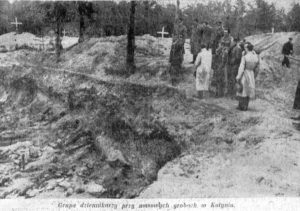
Echter, Pierre Hubermont, die samen met Nand in Katyn was schrijft in zijn ooggetuigenverslag dat hij “ter plaatse sprak met Professor Kozlowski”. Hij wordt geciteerd in de krant “Het Vlaamsche Land” van 28 april 1943 (zie pagina “De Pillecyn in Katyn“). Ook Nand wordt geciteerd in “Het Algemeen Nieuws” van dezelfde dag bij een verslag van een persconferentie over Katyn: “Een professor van de Universiteit van Lemberg (Polen) deelde aan de journalisten mede dat hij zelf en het Poolsche en Baltische volk vóór de poorten van het communisme hebben gestaan”.
Dus dat zou betekenen dat het bezoek van Kozlowski en de delegatie met Hubermont, Nand en Caballero tegelijkertijd plaatsvond, in april, en ze dus wel samen op deze foto kunnen staan. )
Mr. Flood. I now show the witness exhibit No. 19 and ask him if he can identify the person on that picture.
Mr. V. That is myself.
Mr. Flood. What were you doing at the time that picture was taken ?
Mr. V. We were investigating the growth of the grass and of the trees, not as experts.
Mr. Flood. That is all.
Chairman Madden. Any further questions.
Mr. O’Konski. I would like to ask a question.
Chairman Madden: Congressman O’Konski.
Mr. O’Konski. If they exhumed something like 250 bodies, in round figures, why did the propaganda ministry, or whoever had charge of propac’anda, continue to say that there were 11,000 or 12,000 or 15,000 bodies found in Katyn?
Mr. V. We knew from the Poles, who had told us that between 12,000 and 13,000 Polish officers were missing, and we assumed that all of them were l3nng buried in the forest of Katyn. The figure of 11,000 was mentioned at the time when the reburying was still carried out. It had not been complete. It is definitely established that the forest of Katyn contained more dead bodies of Polish officers than the 4,250 which were actually found, because, right at the beginning of June, we discovered a new grave of Polish officers, but we just only opened it a bit and had to close it again, because it was getting so hot at that time of the year that we were afraid of epidemics and we would not take the risk, and this grave has never been opened. And this new grave, which we just opened in one spot and closed up again without investigating it, was located about 200 meters between the so-called Korzy Gory — that is, it was located between these hills and the Dnieper Castle. Not near the low part, inside the forest, in the direction leading toward Dnieper Castle.
Mr. O’Konski. In other words, they used the figure in their propaganda of 11,000 because they felt that if they had an opportunity to dig up all of the graves they might find 11,000 bodies there, because they heard a report that there were that many Polish officers missing, is that correct?
Mr. V. The figure of 11,000 originated from my unit. They were asked by Berlin to name a figure or an estimate, and they actually named 11,000, that is, my unit, but later on they found out that they had erred. it could not be correct. As it is, the Katyn Forest only holds the bodies of the Polish officers who came from the camp of Kozielsk, but not those of the other two camps. Later on we learned that apart from the camp of Kozielsk there were another two very large camps of Polish officers.
Mr. Flood. May I say that that last statement has some significance in view of the fact that at the other two camps referred to by the witness, the one, Starobielsk, and the third, Ostohkov, contained as prisoners, both military and civilian, unaccounted for to date, in the neighborhood of 6 to 8 thousand Poles. The 6 to 8 thousand from the other two camps of Starobielsk and Ostoshkov have not been heard from to this day and their bodies have never been discovered.
Chairman Madden. Is there anything further you would like to say?
Mr. V. The previous witness was questioned as to the exact number of graves. I am in a position to give you the exact number of graves.
Chairman Madden. We will be glad to have it.
Mr. V. There were four old graves and a fifth one, which we discovered later in the forest, and new graves. They laid out four large ones and two smaller, single, ones, six all together.
Chairman Madden. We wish to thank you for your testimony here this afternoon.
The committee will reconvene at 9 : 30 in the morning.
(Whereupon at 7 : 40 p. m., Tuesday, April 22, 1952, a recess was taken until 9 : 30 a. m., Wednesday, April 23, 1952.)
